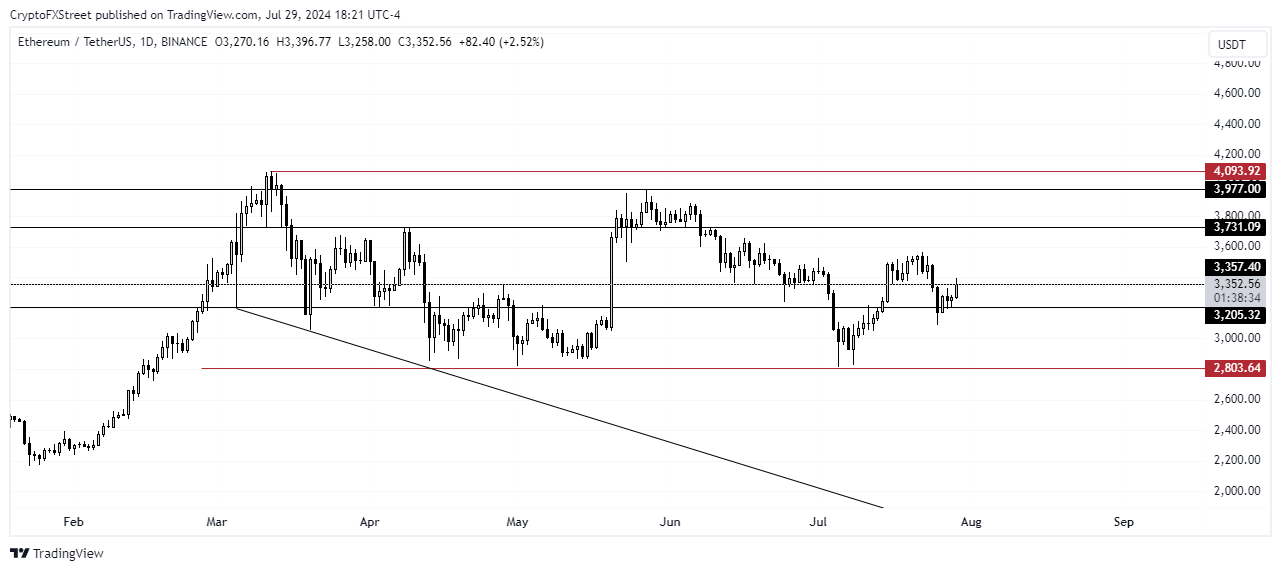Ethereum slips in key metric, falls to fifth position
- Ethereum ETFs launch has attracted increased investors’ interest to Layer 1 protocols.
- Ethereum falls to number five among top fee generating protocols.
- Ethereum may continue trading horizontally until Grayscale ETHE outflows cool.
Ethereum is up 3% on Monday following outflows across Ethereum ETFs and increased attention towards Layer 1 blockchain networks.
Daily Digest Market Movers: Ethereum ETF boosts transparency, sees increased social volume
These are the top Ethereum-related stories in the past few hours:
- Asset manager 21Shares partnered with Chainlink to enable the integration of its Proof of Reserve into 21Shares Core Ethereum ETF (CETH). The move will ensure that 21Shares is transparent about the assets backing CETH.
- Santiment social data shows that investors have shifted their attention from meme coins and low-cap tokens towards major Layer 1s like Ethereum, Bitcoin and Solana. The market has historically shown strength and occasionally rallied when investors focus more on large-cap tokens.
- In a recent analysis by Token Terminal, Ethereum fell to fifth place among the top ten fee-generating protocols in 2024. ETH's drop may be due to fewer and cheaper transactions on Ethereum's Mainnet since the introduction of blobs following the Dencun upgrade in March.
- Ethereum ETFs recorded net outflows of $285 million last week. The outflows came as a result of increased selling pressure on Grayscale Ethereum Trust (ETHE), which saw it witness an exodus of over $1 billion. Many analysts have speculated that it would be difficult to establish the impact of ETH ETFs until ETHE outflows slow down.
- Spot-on-Chain said a big whale deposited 25.8K ETH worth $87M to Binance in the past few hours. From May 31 to July 25, the whale withdrew 26,721 ETH from Binance at an average price of $3,457. He has deposited 26,660 ETH to the CEX at only ~$3,376. His estimated total loss from ETH is $2.16M (-2.34%).
ETH Technical Analysis: Ethereum to continue sideways move
Ethereum is trading around $3,350 on Monday, up 3% on the day. ETH's 24-hour liquidation is $48.37 million, with long and short liquidations accounting for $26.9 million and $21.47 million, respectively.
Ethereum recently broke above the $3,357 resistance despite most traders being bearish, as visible in ETH's Long/Short Ratio, which is at 0.905. The bearish sentiment may be due to investors expecting more price declines due to outflows from ETHE. As a result, ETH may continue its horizontal trend but tilted towards the downside. The move aligns with a drop in ETH options open interest (OI) which declined to $6.09 billion, indicating uncertainty among investors.

ETH/USDT Daily chart
However, ETH could rise similarly to Bitcoin after outflows from Grayscale cooled. Hence, ETH could attempt to break above the $3,730 key resistance.
In the short term, ETH could rise to $3,413, where positions worth $60.21 million risk liquidation.
Ethereum FAQs
Ethereum is a decentralized open-source blockchain with smart contracts functionality. Serving as the basal network for the Ether (ETH) cryptocurrency, it is the second largest crypto and largest altcoin by market capitalization. The Ethereum network is tailored for scalability, programmability, security, and decentralization, attributes that make it popular among developers.
Ethereum uses decentralized blockchain technology, where developers can build and deploy applications that are independent of the central authority. To make this easier, the network has a programming language in place, which helps users create self-executing smart contracts. A smart contract is basically a code that can be verified and allows inter-user transactions.
Staking is a process where investors grow their portfolios by locking their assets for a specified duration instead of selling them. It is used by most blockchains, especially the ones that employ Proof-of-Stake (PoS) mechanism, with users earning rewards as an incentive for committing their tokens. For most long-term cryptocurrency holders, staking is a strategy to make passive income from your assets, putting them to work in exchange for reward generation.
Ethereum transitioned from a Proof-of-Work (PoW) to a Proof-of-Stake (PoS) mechanism in an event christened “The Merge.” The transformation came as the network wanted to achieve more security, cut down on energy consumption by 99.95%, and execute new scaling solutions with a possible threshold of 100,000 transactions per second. With PoS, there are less entry barriers for miners considering the reduced energy demands.

